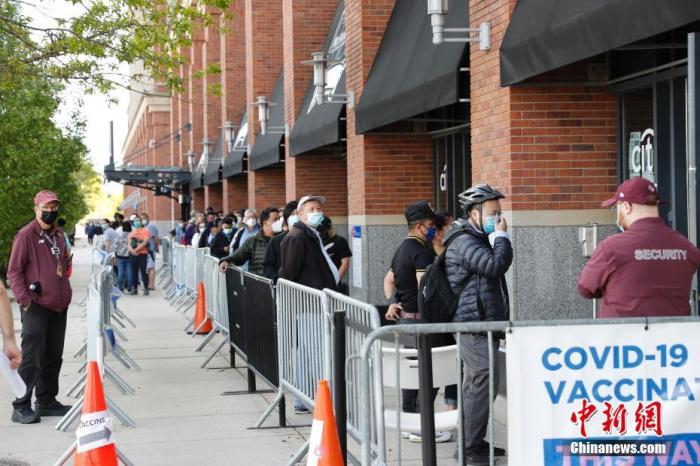China News Service, May 29, reported that the United States recently promised to ship tens of millions of doses of the new crown vaccine overseas.
However, US media pointed out that due to numerous "diplomatic and logistical challenges," the Biden administration has so far failed to fulfill its promises.
On the other hand, more than half of the US population has at least one dose of vaccine.
The US media pointed out that the United States has surplus vaccine supplies that can be shipped overseas.
Data map: On April 23, local time, the American Museum of Natural History in New York opened the Milstein Marine Biology Hall as a new crown vaccination site to vaccinate New York residents over 18 years old.
Photo by China News Agency reporter Liao Pan
According to the National Broadcasting Corporation (NBC), since Biden announced in May that 80 million doses of vaccine will be shipped overseas by the end of June, the White House has not issued a single dose of vaccine.
Currently, the United States has surplus vaccine supplies that can be shipped overseas.
A person familiar with the distribution process said that determining where these doses will be shipped overseas is a daunting task.
According to reports, once the vaccine is produced, it will be sent by the U.S. federal government to tens of thousands of retail pharmacies, vaccination centers and community health clinics across the United States.
This means that there is no storage center that centrally stores millions of doses of vaccines that can be easily packaged and transported by air.
Earlier, White House Coordinator Slavitt said that the United States is trying to shift to a “stricter (vaccine) distribution system” so that the federal government can better track the doses that have been distributed and confirm how many doses are available for export.
A government official said that shipping tens of millions of doses of vaccines around the world faces many challenges, including ensuring that there are enough aircraft to complete these tasks, ensuring that these vaccines are properly stored, and ensuring that the countries receiving these vaccines have refrigeration and distribution. The infrastructure of these vaccines.
The report pointed out that of the 80 million doses of vaccine promised by the Biden administration so far, 60 million doses come from AstraZeneca.
This vaccine has not yet been approved by the U.S. Food and Drug Administration, which is another potential problem facing overseas programs.
The Biden administration stated that even if AstraZeneca vaccines have been approved for use in other countries, they will not be issued until the US regulatory agency approves them.
Data map: On May 12, local time, the New York Mets baseball team's home stadium at Citi Field's new crown vaccination site, people lined up for vaccination.
Photo by China News Agency reporter Liao Pan
The report also said that due to problems with AstraZeneca's research data, the US Food and Drug Administration's review process has been delayed.
At present, it is not clear when or even if the vaccine will be approved in the United States.
In addition, even if all conditions are in place, there is still a question of how to distribute these doses fairly between low- and middle-income countries that desperately need vaccines and US allies.
Except for the broad principle of shipping vaccines to the place where the most lives can be saved, the US government has nothing to say about the specific criteria for how to allocate vaccine doses among countries.
Slavitt said: "These decisions are based on several factors: science and public health, and fairness-no other factors."
At present, Biden has assigned the White House Coordinator Zienz to lead related work. He has been working with National Security Advisor Sullivan and the State Department's Global Coordinator Smith.
Staff from the United States Agency for International Development and the Department of Health are also participating in the development of the plan.
A government official acknowledged the challenges faced by the United States in foreign aid vaccines, but said that this commitment "may be just the beginning."
The United States’ commitment of 80 million doses of vaccines is only a drop in the bucket for international demand.
According to reports, the "New Coronary Pneumonia Vaccine Implementation Plan" (COVAX) led by the Global Alliance for Vaccines and Immunization and WHO has set a goal of distributing 1.8 billion doses of vaccine to low- and middle-income countries in 2021.
On the other hand, as of the 28th, more than half of the US population has received at least one dose of the new crown vaccine.
The US Centers for Disease Control and Prevention updated data that day, showing that in the entire US population, 50.1% of people have received at least one dose of the vaccine, and 40.2% of them have been fully vaccinated.
However, the United States has encountered a vaccination bottleneck. A public opinion survey released on the 27th showed that among the American people who have not yet been vaccinated, the proportion of people who hope to be vaccinated as soon as possible has dropped by 5% compared with April.

